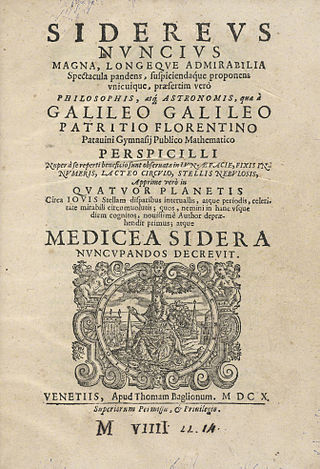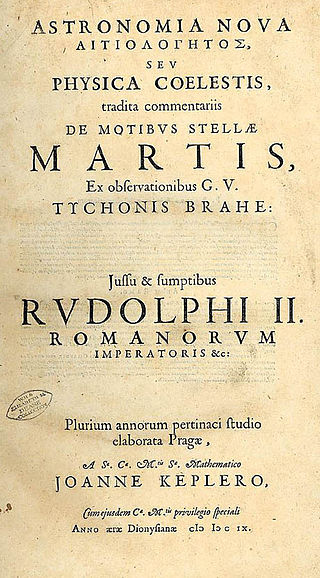Related Research Articles

Sidereus Nuncius is a short astronomical treatise published in New Latin by Galileo Galilei on March 13, 1610. It was the first published scientific work based on observations made through a telescope, and it contains the results of Galileo's early observations of the imperfect and mountainous Moon, the hundreds of stars that were unable to be seen in either the Milky Way or certain constellations with the naked eye, and the Medicean Stars that appeared to be circling Jupiter.

Simon Marius was a German astronomer. He was born in Gunzenhausen, near Nuremberg, but spent most of his life in the city of Ansbach. He is most known for being among the first observers of the four largest moons of Jupiter, and his publication of his discovery led to charges of plagiarism.
The year 1710 in science and technology involved some significant events.
The year 1616 in science and technology involved some significant events.
The year 1638 in science and technology involved some significant events.
The year 1621 in science and technology involved some significant events.
The year 1611 in science and technology involved some significant events.
The year 1612 in science and technology involved some significant events.
The year 1631 in science and technology involved some significant events.

The year 1609 in science and technology involved some significant events.
The year 1613 in science and technology involved some significant events.

Thomas Harriot, also spelled Harriott, Hariot or Heriot, was an English astronomer, mathematician, ethnographer and translator to whom the theory of refraction is attributed. Thomas Harriot was also recognized for his contributions in navigational techniques, working closely with John White to create advanced maps for navigation. While Harriot worked extensively on numerous papers on the subjects of astronomy, mathematics and navigation, he remains obscure because he published little of it, namely only The Briefe and True Report of the New Found Land of Virginia (1588). This book includes descriptions of English settlements and financial issues in Virginia at the time. He is sometimes credited with the introduction of the potato to the British Isles. Harriot was the first person to make a drawing of the Moon through a telescope, on 5 August 1609, about four months before Galileo Galilei.
Events from the 1600s in England. This decade marks the end of the Elizabethan era with the beginning of the Jacobean era and the Stuart period.
The year 1588 in science and technology, Armada year, included a number of events, some of which are listed here.
The year 1586 in science and technology included a number of events, some of which are listed here.
The year 1560 in science and technology included a number of events, some of which are listed here.
The year 1553 CE in science and technology included a number of events, some of which are listed here.
Sir William Lower was an English astronomer from the early telescopic period, and a Member of Parliament.
References
- ↑ "Thomas Harriot (1560–1621)". The Galileo Project. 1995. Retrieved 2012-07-04.
- ↑ Williams, Hywel (2005). Cassell's Chronology of World History. London: Weidenfeld & Nicolson. pp. 243–248. ISBN 0-304-35730-8.
- ↑ Armytage, W.H.G. (1960). "Giambattista della Porta and the Segreti". British Medical Journal . 1 (5179): 1129–30. doi:10.1136/bmj.1.5179.1129. PMC 1966956 .